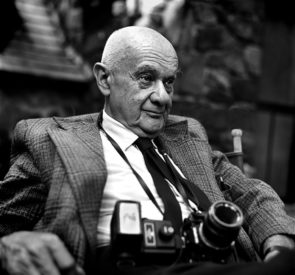Berkeley Talks: Scholars on Roman Vishniac’s photos of Jewish life before WWII
“These photographs have come to be seen as a last glimpse of a murdered population and a destroyed way of life,” said a professor of Jewish studies at a UC Berkeley event in May
May 20, 2022
Follow Berkeley Talks, a Berkeley News podcast that features lectures and conversations at UC Berkeley. Review us on Apple Podcasts.

In the study of Rabbi Baruch Rabinowitz in Mukacevo, ca. 1937-8. (Photo by Roman Vishniac via The Magnes on Flickr)
In Berkeley Talks episode 141, a panel of scholars discuss the work of Roman Vishniac, a renowned Russian American photographer who took thousands of photos over seven decades and across three continents.
Although Vishniac’s genres were diverse, he’s best known for images that he took of Jewish life in Central and Eastern Europe before the Holocaust.
“Why do his pictures of Jewish life in Poland, Czechoslovakia and Romania, made approximately between 1935 and 1938, now loom so large in Vishniac’s extensive corpus?” asked Jeffrey Shandler, professor of Jewish studies at Rutgers University, at a UC Berkeley event in May.
“These photographs are distinguished by their epiphenomena, the life circumstances of their subjects and the narratives that have surrounded these images,” Efron continued. “Shortly after these photographs were taken, most of the Jews they depict met a terrible fate during World War II. Those few who survived the Holocaust had to start their lives over in radically different circumstances.
“As a consequence, these photographs have come to be seen as a last glimpse of a murdered population and a destroyed way of life, referred to repeatedly, including in conjunction with Vishniac’s work, as a ‘vanished world.’”
Also on the panel were moderator Barbara Kirshenblatt-Gimblett, university professor emerita and professor emerita of performance studies at New York University and chief curator of the Core Exhibition at POLIN Museum of the History of Polish Jews, and Ben Schiff, emeritus professor of politics at Oberlin College and the grandson of Vishniac, who spoke about Vishniac’s life, his love of nature and science, and his pioneering contributions to photomicroscopy.

David Eckstein at 7 years old with classmates in cheder (Jewish elementary school) in Brod, (Carpathian Ruthenia/Czechoslovakia), ca. 1938. Eckstein survived the Holocaust and went on to do an interview with the USC Shoah Foundation as an adult. (Photo by Roman Vishniac via The Magnes on Flickr)
“Roman was much more than a photographer,” said Schiff. “I think he saw himself as part of the tradition of the natural philosopher, a synthetic thinker along the lines of Alexander von Humboldt perhaps, whose explorations, that is Roman’s explorations, took place, not in the exotic locales that von Humboldt explored so much as in the boundless expanses of the micro world.”
The panel discussion was part of Roman Vishniac. In Focus: 1922-2022, a two-day Berkeley event that included an open house on May 1 at The Magnes Collection of Jewish Art and Life and a daylong virtual symposium on May 2 that brought together scholars from across the world to discuss the historical context and content of Vishniac’s photographs.
The event, presented by The Magnes in collaboration with Berkeley’s Center for Jewish Studies, celebrated the reopening of The Magnes and the richness of the Roman Vishniac Archive, which includes over 30,000 images, audiovisual materials, correspondence and memorabilia appraised at more than $38.5 million. They were donated in 2018 by Vishniac’s daughter, Mara Vishniac Kohn, who worked closely with The Magnes curatorial staff to ensure the unprecedented gift — the third largest in UC Berkeley’s history — would come to The Magnes.

On May 1, The Magnes celebrated the museum’s reopening and the Roman Vishniac Archive with an open house. From left: Aubrey Pomerance, director of archives of the Jewish Museum Berlin; Naomi Schiff, granddaughter of Vishniac; Benjamin Schiff, Vishniac’s grandson; John Efron, faculty director of The Magnes and Koret Professor of Jewish History at Berkeley; and Francesco Spagnolo, curator of The Magnes. (Photo by Catharyn Hayne / KLC Fotos via The Magnes on Flickr)
“In her last years, she increasingly worried about what was happening with the archive and we began discussions with The Magnes Collection and curator Francesco Spagnolo about possibly donating the materials here,” said Schiff. “[Mara] was so relieved and really joyful, when in late October 2018, a climate-controlled truck was loaded in New York and the materials were shipped here safely. Mara passed away about six weeks later, her labors to assure the future of her father’s work successfully concluded.”
In February, The Magnes was awarded a $1 million gift, which will be used, along with major gifts from other foundations and donors, to digitize and catalog the archive.
“I am elated!” said John Efron, faculty director of The Magnes and Koret Professor of Jewish History at Berkeley, in a press release from The Magnes. “This remarkably generous gift assures the future of the Roman Vishniac Archive and further cements The Magnes and UC Berkeley as major resources in the world of Jewish studies scholarship and teaching. We are deeply grateful.”
Watch the two additional panel conversations from the symposium, plus other videos related to the Roman Vishniac Archive, on The Magnes’ YouTube page.
Learn more about the Roman Vishniac Archive at The Magnes.
View more of Vishniac’s photos on The Magnes’ Flickr page.
Also read a Berkeley News story from 2018 about the archive: ‘Vanished no more: Giant of photography Roman Vishniac finds a home at The Magnes.’
Listen to other episodes of Berkeley Talks:
